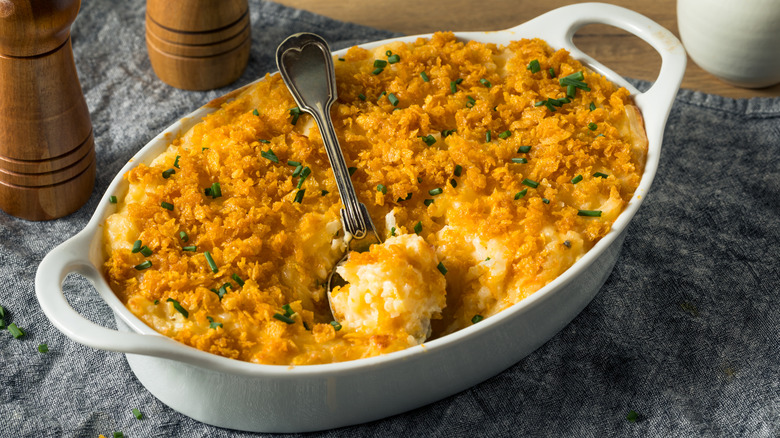If Your Parents Fed You This Meal As A Kid, You Probably Grew Up In The Midwest
What could be better than perfectly crispy tator tots, baked with gooey cheese, creamy-sauced veggies, and a savory protein? If you grew up in the Midwest, you're probably familiar with this combination of ingredients best known as "hot dish," a style of casserole that remains a mainstay of Midwestern home cooking.
The Midwest is synonymous with comfort food that feeds a crowd, and hot dish is no exception. Hot dish is a versatile one-dish casserole that hails from Minnesota and North Dakota and includes four key elements: a creamy base, vegetables, a protein, and a starch. While hot dish is technically a casserole, not all casseroles are hot dishes. The main difference is that a hot dish is always enjoyed as the main entree, as opposed to a dish like green bean casserole, which is served as a side. Additionally, a hot dish must be baked in the oven.
Just as Shipwreck Casserole epitomized Depression-era cooking, the hot dish originated in the 1930s among farmwives looking for a cost-effective, filling way to make meals with shelf-stable pantry ingredients like canned soup and vegetables. The term "hot dish" first appeared in a 1930 Minnesota cookbook created by the Grace Lutheran Ladies Aid. The original recipe called for a couple of simple ingredients: canned peas and tomato soup, celery, Creamettes (a Minnesotan brand of macaroni), hamburger, and onions – though a second recipe for hot dish in the book included tuna and spaghetti.
However, in the 1950s, the hot dish recipe evolved with the advent of tater tots. Looking for ways to use up leftover scraps from their frozen french fries, Ore-Ida founders Nephi and Theodore Golden Grigg decided to chop, season, and shape them into small nuggets, which were then deep-fried. After tater tots hit grocery stores in 1956, people started topping their hot dishes with the fried potato bites — a style of hot dish that remains popular to this day.
Other ways to enjoy this Midwestern classic
Everyone has their own twist on hot dish; however, the one-pot meal is usually made in a rectangular baking dish with a creamy canned soup, canned vegetables, some protein, a carbohydrate like rice, noodles, or tator tots, and, if you're lucky, a Great Lakes-sized serving of cheese. Many hot dish recipes also feature a crispy topping, such as chow mein noodles, crushed potato chips, or french-fried onions.
There are some Midwestern foods you rarely see anymore, but hot dish is still a go-to entree for church potlucks and family reunions — and for good reason. The beauty of hot dish is its versatility and ability to stretch ingredients. It's one of those entrees you can make with whatever is in the fridge and cupboard. For example, you could easily add beans and salsa to give the casserole a Mexican-inspired spin, or splurge on fresh veggies to add a delicious twist – we're thinking sauteed mushrooms, garlic, and shallots. If you don't want to use ground beef, you can make a hot dish with tuna or chicken instead, or take a page out of Governor Tim Walz's cookbook and make his turkey trot tater tot hot dish, which features ground turkey and bacon, among other tasty ingredients.
While many hot dish recipes you find online feature tater tots, if you grew up in the Midwest, you probably also remember chicken and wild rice hot dish – a creamy comfort casserole made with chicken, cream of chicken soup, wild rice, and topped with potato chips or crackers — or hot dish cousin, funeral potatoes, a classic side with a very morbid name, which combines frozen hash browns, sour cream, creamy canned soup, and plenty of cheddar cheese. What these beloved Midwestern dishes share — besides nostalgia — is that they use affordable, easy-to-find ingredients and pantry items that taste great when baked together in a pan and evoke feelings of warmth, comfort, and feeding a crowd.


